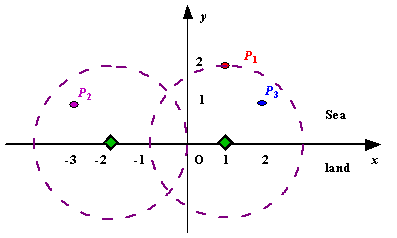|
Radar Installation
Description
Assume the coasting is an infinite straight line. Land is in one side of coasting, sea in the other. Each small island is a point locating in the sea side. And any radar installation, locating on the coasting, can only cover d distance, so an island in the sea can be covered by a radius installation, if the distance between them is at most d.
We use Cartesian coordinate system, defining the coasting is the x-axis. The sea side is above x-axis, and the land side below. Given the position of each island in the sea, and given the distance of the coverage of the radar installation, your task is to write a program to find the minimal number of radar installations to cover all the islands. Note that the position of an island is represented by its x-y coordinates. 
Figure A Sample Input of Radar Installations Input
The input consists of several test cases. The first line of each case contains two integers n (1<=n<=1000) and d, where n is the number of islands in the sea and d is the distance of coverage of the radar installation. This is followed by n lines each containing two integers representing the coordinate of the position of each island. Then a blank line follows to separate the cases.
The input is terminated by a line containing pair of zeros Output
For each test case output one line consisting of the test case number followed by the minimal number of radar installations needed. "-1" installation means no solution for that case.
Sample Input 3 2 1 2 -3 1 2 1 1 2 0 2 0 0 Sample Output Case 1: 2 Case 2: 1 Source
题意:
以X轴为岸边,X轴以上部分为海洋,海洋上分布着小岛,现在要在岸边建立雷达监视小岛,问至少要建多少雷达。
思路:
雷达的监控范围是以D为半径的圆。则以小岛为圆心,以D为半径画圆,这个圆与X轴的交点区间就是可以放置雷达的区间,若小岛的Y大于D,则无论如何都与X轴没有交点,则不会完全覆盖。
在都有交点的前提下,这些区间就转换成了最基本的贪心问题——选活动,一个区间的起点大于前面所有区间的起点终点,则应该在建设一个雷达。
|
贪心——Radar Installation
最新推荐文章于 2022-04-13 21:57:50 发布
























 198
198

 被折叠的 条评论
为什么被折叠?
被折叠的 条评论
为什么被折叠?








